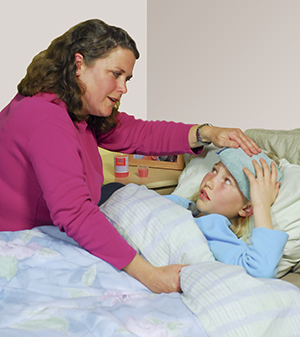When Your Child Has Migraine Headaches
When Your Child Has Migraine Headaches
Migraines are a type of severe headache. They can be very painful. But there are things you can do to help your child feel better. And you may be able to help your child prevent migraines.
The stages of migraines
Migraines often progress through 4 stages. Your child may or may not have all 4 stages. And the stages may not be the same every time a migraine occurs. The 4 basic stages of migraine headaches are:
Prodrome. In this early stage, your child may feel tired, uneasy, or moody. It may be hours or days before the headache pain starts.
Aura. Up to an hour before a migraine, your child may have an aura (odd smells, sights, or sounds). This may include flashing lights, blind spots, other vision problems, confusion, or trouble speaking.
Headache. Your child has pain in one or both sides of the head. Your child may feel nauseated and have a strong sensitivity to light, sound, and odors. Vomiting or diarrhea may also occur. This stage can last anywhere from a few hours to a few days.
Postdrome or recovery. For up to a day after the headache ends, your child may feel tired, achy, and “wiped out.”
What causes migraine?
It is not clear why migraines occur. If a family member has migraines, your child may be more likely to have them. Many people find that their migraines are set off by a “trigger.” Common migraine triggers include:
Chemicals in certain foods and drinks, such as aged cheeses, luncheon meats, chocolate, coffee, sodas, and sausages or hot dogs
Chemicals in the air, such as tobacco smoke, perfume, glue, paint, or cleaning products
Dehydration (not enough fluid in the body)
Not enough sleep or too much sleep
Hormone changes during puberty
Environmental factors, such as bright or flashing lights, hot sun, or air pressure changes
What are the symptoms of migraines?
Your child may have some or all of these symptoms:
Pain, often severe, occurring in a specific area of the head (such as behind one eye)
Aura (odd smells, sights, or sounds)
Nausea, vomiting, or diarrhea
Sensitivity to light or sound
Feeling drowsy
How are migraines diagnosed?
To diagnose migraine headaches, the healthcare provider will:
Examine your child and ask about your child’s symptoms and any other health issues your child may have. You may also be asked if a family member has a history of migraine headaches.
Ask you and your child to keep a “headache diary” for a short period. This means writing down what time of day your child gets headaches, where the pain is felt, how often the headaches happen, and how bad the headaches are. You may also be asked to write down things that make the headache better or worse. The diary can help the healthcare provider learn more about the headaches and determine the best treatment.
Before diagnosing migraines, your child's healthcare provider may order a CT scan or MRI.
How are migraines in children and teens treated?
How your child's migraines are treated will depend on how often he or she has a migraine and how severe they are. If diagnosis is difficult, your child's primary care provider may recommend you see a headache specialist. For some children, sleep will relieve the headache. There are many medicines available for use in children and teens with migraines. Some of these medicines are FDA approved. Others are used off-label. These medicines include triptans, ergot preparations, anti-seizure medicines, calcium channel blockers, beta blockers, antidepressants, and NSAIDs (nonsteroidal anti-inflammatory drugs). Some over-the-counter products may relieve some migraines. For mild to moderate migraine, use acetaminophen, ibuprofen, and naproxen early in the course of the headache. If your child also has poor appetite, abdominal pain, and vomiting with migraine, your healthcare provider may prescribe drugs that treat nausea and vomiting.
Overuse of headache medicines can cause rebound headaches. Use all medicines with care, including over-the-counter drugs and prescriptions. Consult your child's healthcare provider if your child is taking any medicine for headache more than twice a week.
There are 2 general approaches to treatment:
Acute treatment uses drugs to relieve the symptoms when they occur.
Preventive treatment uses drugs taken daily to reduce the number of attacks and lessen the intensity of the pain. If a child has 3 or 4 severe headaches a month, your child's healthcare provider may prescribe preventive medicine. These include certain anticonvulsants, antidepressants, antihistamines, beta-blockers, calcium channel blockers, and NSAIDs.
Your healthcare provider may suggest certain herbals and supplements, such as butterbur, magnesium, riboflavin, CoQ10, and feverfew.
Lifestyle changes may also help control migraines. This includes using relaxation techniques (biofeedback, imagery, hypnosis, etc.), cognitive-behavioral therapy, acupuncture, exercise, and proper rest and diet to help avoid attack triggers. For some children, eating a balanced diet without skipping meals, getting regular exercise, and a consistent sleep schedule help reduce migraines.
What are the long-term concerns?
As your child gets older, the frequency of migraine may change. The likelihood of lifelong migraine may also increase if one parent has lifelong migraines.
When should I call my healthcare provider?
Call your child’s healthcare provider right away if your child has any of the following
Headache pain that does not respond to your routine treatment
Headache pain that seems different or much worse than previous episodes
Headache upon awakening or in the middle of the night
Dizziness, clumsiness, slurred speech, or other changes with a headache
Migraines that happen more than once a week or suddenly increase in frequency
Unless advised otherwise by your child’s healthcare provider, call the provider right away if:
Your child has a fever greater than 100.4°F (38°C)
Your baby is fussy or cries and cannot be soothed.
Your child has a stiff neck.
Updated:
August 15, 2018
Sources:
Acute treatment of migraine in children, Up To Date
Reviewed By:
Adler, Liora, C., MD,Bass, Pat F., III, MD, MPH
